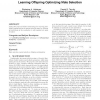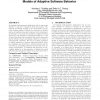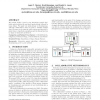GECCO
2008
Springer
15 years 1 months ago
2008
Springer
We propose a network characterization of combinatorial fitness landscapes by adapting the notion of inherent networks proposed for energy surfaces [5]. We use the well-known fami...
68
Voted
GECCO
2008
Springer
15 years 1 months ago
2008
Springer
This poster paper presents a methodology for removing userdefined parameters at the parent selection stage, by allowing all individuals in the population to self-organize into pa...
93
Voted
GECCO
2008
Springer
15 years 1 months ago
2008
Springer
Increasingly, high-assurance applications rely on autonomic systems to respond to changes in their environment. The inherent uncertainty present in the environment of autonomic sy...
GECCO
2008
Springer
15 years 1 months ago
2008
Springer
79
Voted
GECCO
2008
Springer
15 years 1 months ago
2008
Springer
We present IGAP, a peer to peer interactive genetic algorithm which reflects the real world methodology followed in team design. We apply our methodology to floorplanning. Throu...
GECCO
2008
Springer
15 years 1 months ago
2008
Springer
In this paper, we report on our investigation of factors affecting the performance of various parallelization paradigms for multiobjective evolutionary algorithms. Different paral...
GECCO
2008
Springer
15 years 1 months ago
2008
Springer
This paper studies the issue of space coordinate change in genetic algorithms, based on two methods: convex quadratic approximations, and principal component analysis. In both met...
126
click to vote
GECCO
2008
Springer
15 years 1 months ago
2008
Springer
New multimedia embedded applications are increasingly dynamic, and rely on Dynamically-allocated Data Types (DDTs) to store their data. The optimization of DDTs for each target em...
94
Voted
GECCO
2008
Springer
15 years 1 months ago
2008
Springer
We present a force-based genetic algorithm for self-spreading mobile nodes uniformly over a geographical area. Wireless mobile nodes adjust their speed and direction using a genet...
101
Voted
GECCO
2008
Springer
15 years 1 months ago
2008
Springer
We propose an algorithm for function approximation that evolves a set of hierarchical piece-wise linear regressors. The algorithm, named HIRE-Lin, follows the iterative rule learn...



